Sewing - Neckline and Collars | 11th Textiles and Dress Designing : Chapter 12 : Basic Sewing
Chapter: 11th Textiles and Dress Designing : Chapter 12 : Basic Sewing
Neckline and Collars
NECKLINE AND COLLARS
Introduction
A neckline is the part of bodice around the neck.
It can be of various shapes and sizes. Neckline is a very important part of any
garment. One should be very careful while selecting a neckline and also while
stitching it. A neckline should not only be comfortable but should also suit to
the type of fabric. Neckline can be divided as front bodice neckline and back
bodice neckline. Correct neck-line can help to modify the look of the wearer.
Neckline can be used as decora-tion on dresses. The depth and width of neckline
depends upon the wearer, age, sex, type of fabric used and the type of dress
(Figure 12.15).
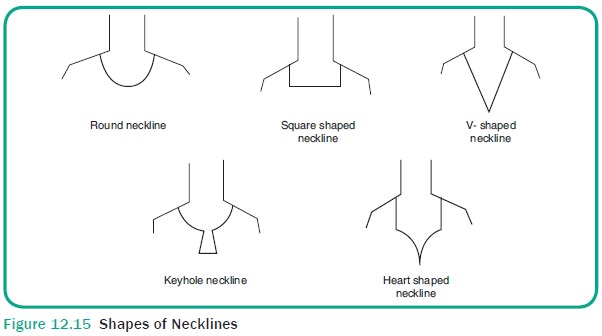
Types of Neckline
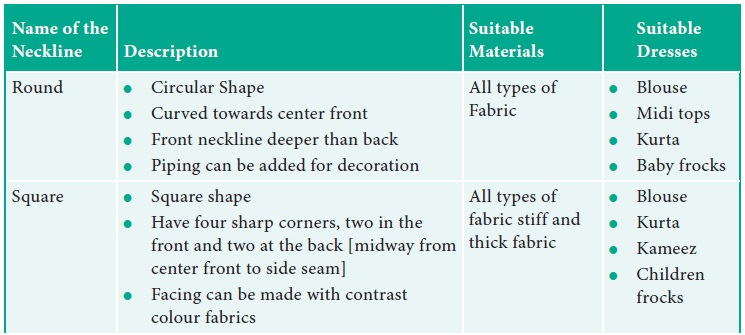
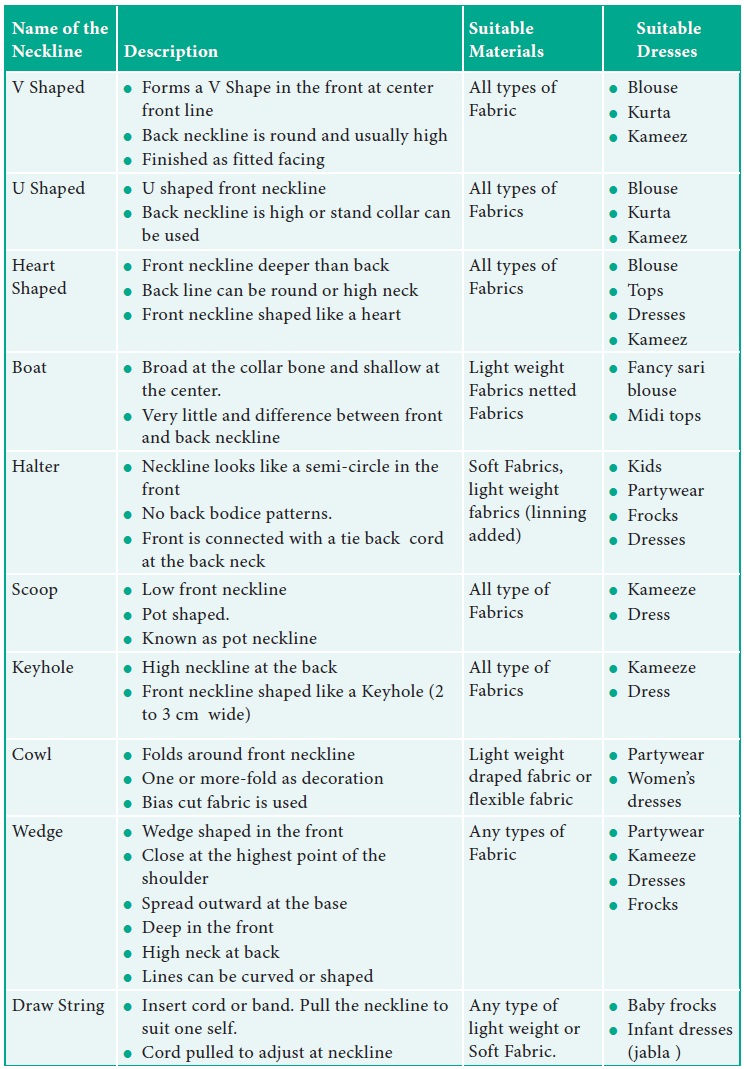
Determination of the Height and Width of NeckLine
The height and the width of the neckline vary
from person to person. It should be fixed before drafting the diagram. For a
neckline, width and depth are required as explained below (Figure 12.16).
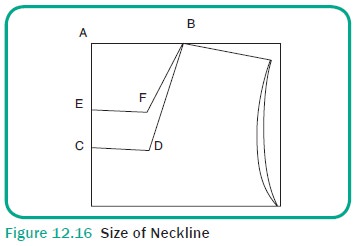
A – B = Front and back neck width
A – C = Front neck depth
B – D – C = Front neckline
A – E = Back neck depth
B – F – E = Back neckline
Neckline Finishing
Finishing of the neckline is of great
impor-tance. It affects the final appearance of the garment and also undergoes
much strain while wearing the dress especially dresses without fasteners. Hence
the neckline finish must be stronger. Neckline finish increases the durability
of the garment. It should retain the shape and size. Mostly bias strips are
used to finish the necklines, because of its stretchability. Most necklines are
finished in one of the following three ways :
·
With facings.
·
With bindings.
·
With a collar.
The major points to be considered while finishing
the neckline are :
·
Neckline edges must retain shape and must not
stretch (curves & corners).
·
Seam must be thin and smooth.
·
Facing edges must be beneath the collar/neckline
.
Bias Piece
A true bias is a diagonal line at 45o to the
lengthwise or crosswise grain. It has the maximum elasticity more than any
other direction in the cloth. Bias stripes can be applied as facings and
bindings and espe-cially used for finishing curved edges such as neckline,
sleeveless, armholes and scallops.
Cutting Bias Strips
Fold the fabric diagonally so that the lengthwise
threads of the folded part fall parallel to the crosswise threads on the rest
of the material. Using a ruler, measure from the fold to desired width of bias
strip (usually 2- 2.5 cm) and draw parallel lines. Cut along the marked lines
and trim off ends along the warp threads.
Joining of Bias Strips
Place the bias stripes with their right sides
facing each other. The edges of the cut ends should coincide. Shift the top
strip 0.5 cm beyond the other so that the sharp points at the ends of the
strips project on either side. Stitch a 0.5 cm seam joining the points where
the sides of the two stripes intersect. Press the seam open and trim the seam
projection (Figure 12.17).
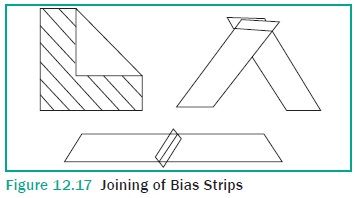
Facing
Facing are used to provide a neat finish to the
raw edges in a garment. It also sup-ports the shape of a neckline, armhole and
collars. When the neckline is straight, the facing must be cut in one piece
with the garment section. If the shape is curved, the facing must be cut in
bias. Facing may appear on the right side of the garment and the colour of the
facing should match with the colour of the garment fabric. Decorative facings
are usually made with scalloped points or other designs along the outer edge.
Bias facings can be applied on the right side of the garment for deco-rative
effects (Figure 12.18).
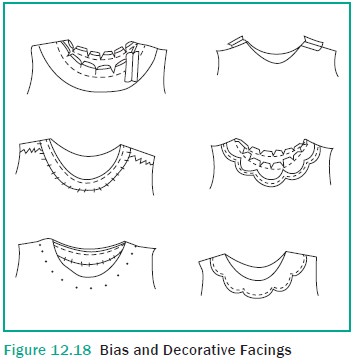
Bindings
Bias binding is used to finish and strengthen raw
edges and to add decorative trim to a garment. It shows both on the right and
wrong side of the garment. When finished, bias binding should have uniform
width (less than 0.25 cm) and should lie flat and smooth without any stitches
showing on the right side of the garment. There are two kinds of bias binding,
Single bias binding and French binding or piping (Figure 12.19).
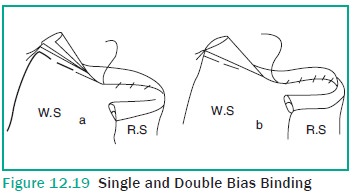
Collar
A collar is added to a neckline to enhance its
appearance. Collars are made of double layer of fabrics. It also helps to
finish the raw edges of the neckline. Since collars form a background to the
face they should suit the wearer. Several factors are considered while
designing collars. The major factors are :
·
Design of fabric – the collar design should
harmonize with fabric design.
·
Colour and texture of the fabric – there should
be harmony between the fabric used for collar and the base garment.
·
Pattern of the garment – the design of the collar
should suit the pattern of the dress.
·
Purpose and use of the garment – collars should
be selected according to the end use of the garment.
·
Sex and age of the wearer – suitable collars
should be selected for men, women and children.
·
Appearance of the wearer- facial shapes and size
of the neck are important factors to be considered while designing collars.
Types of Collars
The collar edge can be round, curved, square or
pointed depending upon design variation. A collar can be made close to or away
from the neckline. Some of the types of collars are round collar, peter pan
collar, scalloped col-lar, sailor collar, roll collar, shirt collar, band
collar, and shawl collar (Figure 12.20).
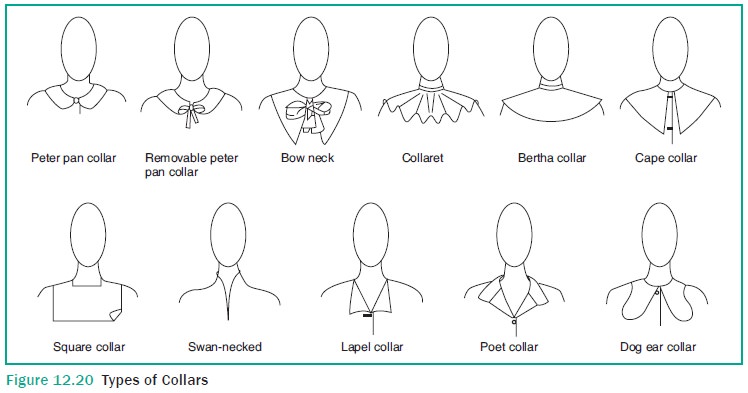
Round collar or one piece Peter Pan collar
·
Round collar or one piece Peter Pan collar is
mostly used for children’s dresses. The front collar continues to the back
where it is divided with rounded ends. If this collar pattern is cut at the
centre front and back to get two pattern pieces it is called two piece peter
pan collar. A scalloped collar can also be created by just shaping the col-lar
edges as scallops (Figure 12.21).
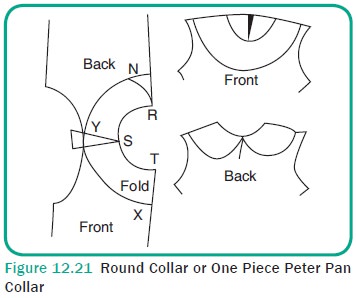
Method
of Drafting a Round Collar
·
First duplicate the neckline area of the garment
as in the figure.
·
Keep the front and back bodice pat-terns together
on a paper, with neck points of shoulder lines touching with the pattern
overlapping 0.25 cm near the shoulder as illustrated in the figure.
·
Trace the outline of the upper part of the
bodice.
·
Label the front neckline as
o
Shoulder – S.
o
Back neckline – Y.
o
Fold – 0.5 cm.
·
Join XYZ as shown in the figure (3-7 cm away from
the neckline).
·
Make a notch at the shoulder S to indicate
shoulder points.
·
Label collar as shown in the figure and cut the
collar pattern.
·
This is the drafting of a flat collar or
one-piece peter pan collar
·
By cutting at the center front of the collar,
two-piece peter pan collar can be prepared.
Sailor Collar
·
Sailor collar is a flat turned down col-lar. It
has a V shape in front and square shape at the back (Figure 12.22).
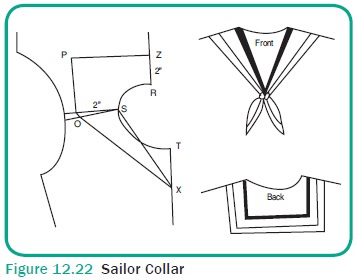
Method of
Drafting a Sailor Collar
·
The pattern is made by marking as V shape at
point X bodice front neck-line about 7 to 8 cm below. Connect shoulder point S
and X on the center front line
·
Trace on a sheet of paper the neck-line area of
back and modified front bodice patterns after overlapping the shoulder 0.25 cm
near armhole
·
Mark the back neckline point as O. Mark points
alone center back line and shoulder line measuring 5 cm.
·
Extend to point P and connect at point Z
· Join all the lines of the pattern as in figure
Shirt Collar
Shirt collar, as the name indicates it is used in
the men’s, women’s or kid’s shirt. Generally, it consists of two parts
com-monly known as band to hold the other part which is the collar. Sometimes
kid’s shirt collars are designed without the stand (Figure 12.23).
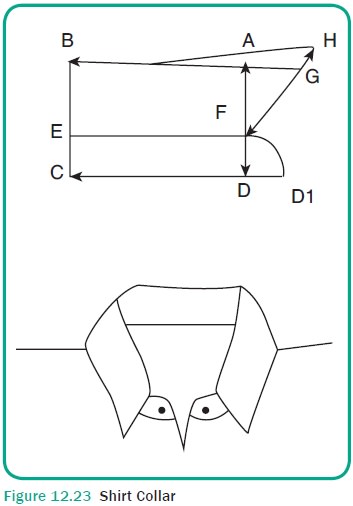
Method
of Drafting a Shirt Collar
·
Draw a rectangle ABCD where CB = height of collar
+ 5 cm for band width and CD is ½ neckline measurements
·
Mark the following points measur-ing CE and DF =
Band width (5 cm)
·
Extend the points D to D1 = 2 cm and A
to H = 4 cm and H and G ( diagonal top) = 1 cm
·
Join the points as shown in the figure
·
The stand part of the collar (without the
extension) along can be used to draft band or stand collars, which is used in
kurta. The edges of the collar are reduced by 2 cm to have small opening at the
center front.
Method of Sewing Collars
·
Match the neckline of the garment and collar
pattern
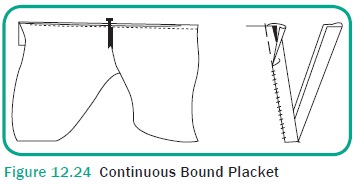
·
Place the wrong sides facing together pin or back
alone the sewing line
·
Machine along the sewing line
·
Remove pins or tacked stitches
·
Turn to right side
·
Press neatly
·
For shirt collar the seam line are stitched and
then the whole collar piece is turned around. The seams are not seen in the
finished garment
Summary
Neckline is an important part of the gar-ment.
There are different types of neck-lines named based upon its shape like round
neckline, square neckline, boat neckline etc. Finishing of necklines are done
with facing, bindings and collars.
POINTS TO REMEMBER
·
Neckline has to be finished neatly. It should be
flat on the body to add grace to the garment. Bias strips are cut in cross
grain at 45o angle.
·
Neckline can be finished by binding and facing.
·
Round collar/peter pan collar are usually used in
kids and women’s garments.
·
Sailor collar is a decorative collar. It has a
square flap along the back neckline but forms V shape in the front neckline.
·
Shirt collar are normally stitched with a band
for men and women and without band for kids.
ACTIVITIES FOR THE TEACHER
·
Give demonstration for stitching facings,
bindings and collars.
ACTIVITIES FOR STUDENTS
·
To collect pictures of the different types of
necklines and make an album with description.
·
To stitch on muslin a facing, binding and a
simple round collar and prepare a record.
Related Topics